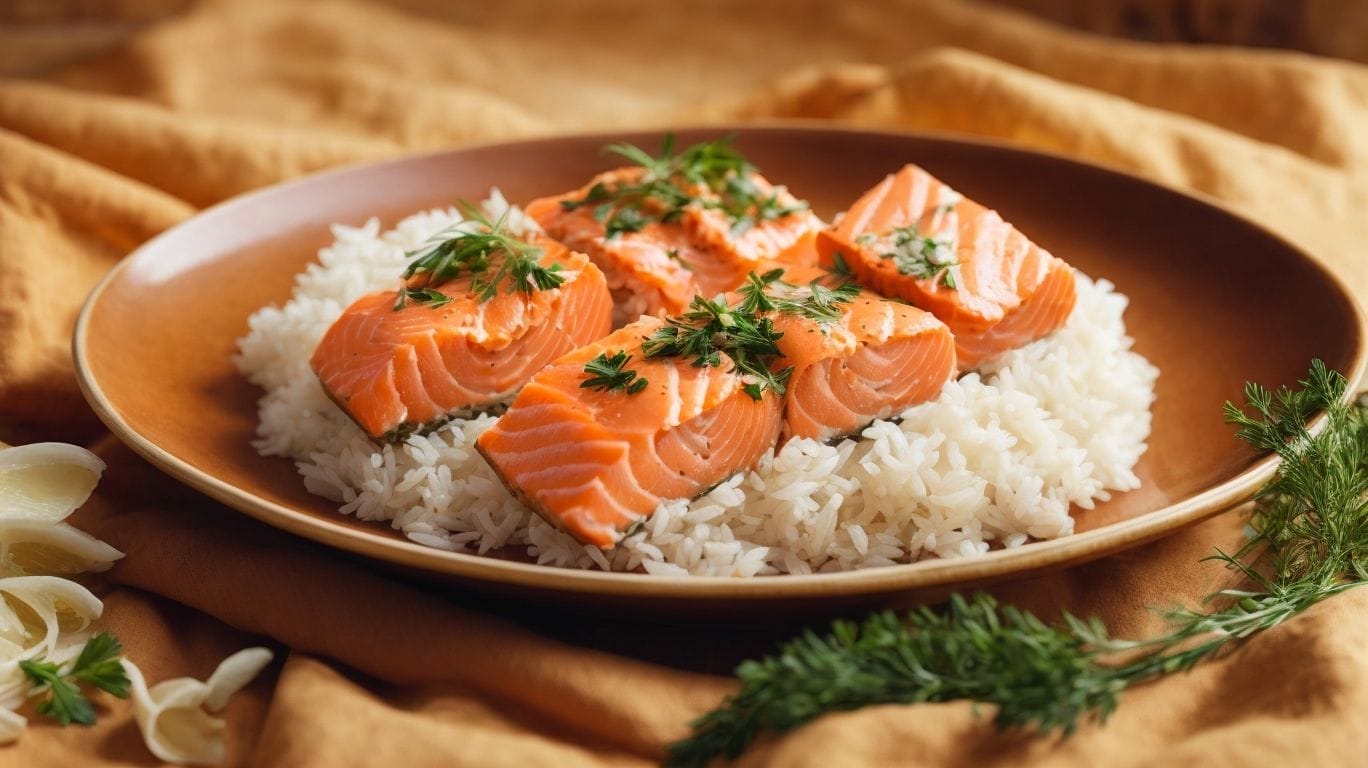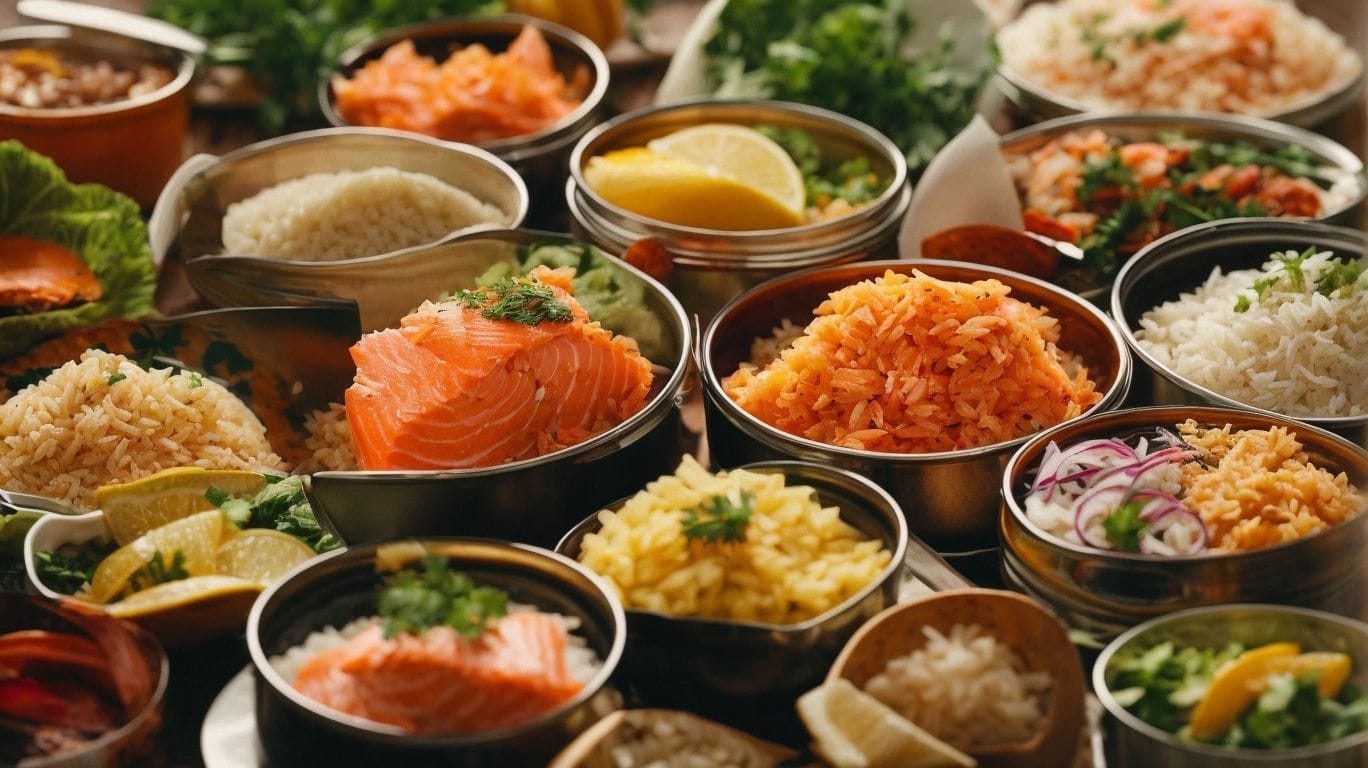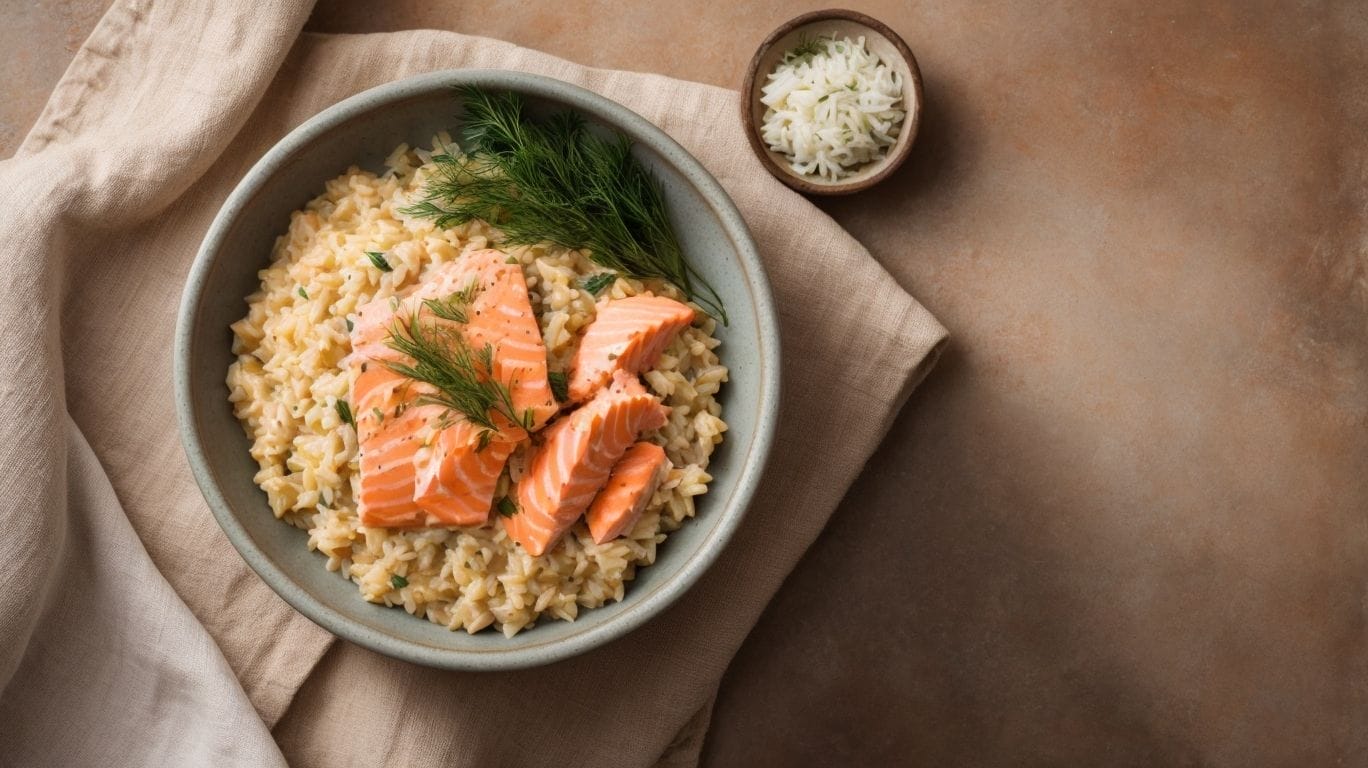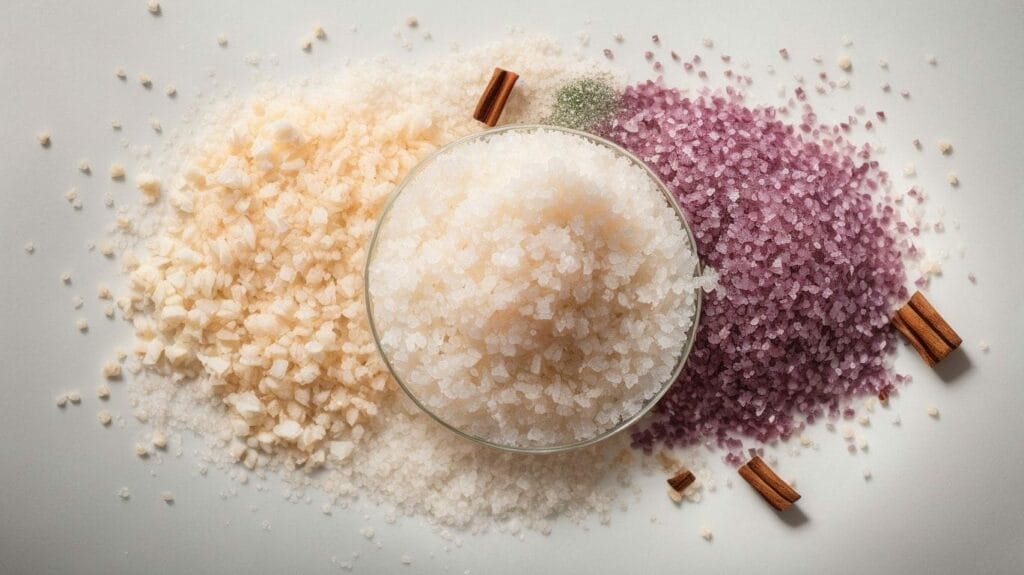Canned salmon is a versatile and nutritious ingredient that can be used to create delicious and satisfying meals, particularly when paired with rice. Not only does canned salmon provide numerous health benefits, but it also offers a variety of culinary possibilities.
Understanding the nutritional benefits of canned salmon is essential. It is packed with essential omega-3 fatty acids, high-quality protein, and important minerals such as calcium and iron. These nutrients contribute to heart health, brain function, and overall well-being.
Including canned salmon in your diet is highly recommended. It can help improve cardiovascular health, support brain function and development, and reduce the risk of chronic diseases. Canned salmon is a convenient and cost-effective alternative to fresh salmon, making it accessible for people of all budgets.
There are different types of canned salmon available in the market. Varieties include pink salmon, sockeye salmon, and coho salmon. Each type has its unique flavor and texture, allowing for diverse recipe options.
When it comes to canned salmon recipes with rice, there are several popular choices. These include salmon fried rice, salmon and rice casserole, and salmon and brown rice salad. These recipes combine the goodness of salmon with the nutritional benefits of rice, creating a balanced and flavorful meal.
For those seeking healthier alternatives or modifications, there are various options. You can make these recipes healthier by using whole-grain rice, reducing sodium, and adding more vegetables. You can experiment with substituting rice with other grains or vegetables to suit dietary preferences or restrictions.
Before cooking with canned salmon and rice, it is important to prepare the canned salmon properly. This involves draining and removing any skin or bones. Cooking techniques such as baking, grilling, or pan-searing work well with canned salmon, as they help retain the flavor and texture.
By understanding the benefits of canned salmon, exploring various recipe options, making healthier modifications, and employing the right cooking techniques, you can enjoy a delicious and nutritious canned salmon dish with rice.
Key takeaways:
- Canned salmon is a nutritious choice: Canned salmon is packed with essential nutrients like omega-3 fatty acids, protein, and vitamin D, making it a healthy addition to your diet.
- Delicious and versatile recipes: There are various delectable canned salmon recipes with rice to try, such as salmon fried rice, salmon and rice casserole, and salmon and brown rice salad.
- Customize for a healthier option: You can make these canned salmon recipes with rice healthier by substituting rice with other grains or vegetables and incorporating modifications to reduce sodium or fat content.
Benefits of Canned Salmon

Photo Credits: Refuelrecipes.Com by Vincent Hall
Canned salmon offers numerous benefits for health-conscious individuals.
- High in omega-3 fatty acids, which support heart health and reduce inflammation.
- Rich in protein, it is essential for muscle repair and growth.
- Contains vitamin D, promoting bone health and immunity.
- Convenient and long-lasting, it is perfect for quick and nutritious meals.
- It is aneconomical option compared to fresh salmon, making it accessible to a wider range of consumers.
Canned salmon provides a multitude of benefits for those who prioritize their health. It is high in omega-3 fatty acids, crucial for supporting heart health and reducing inflammation. Additionally, this seafood is rich in protein, which is essential for muscle repair and growth. Moreover, canned salmon contains vitamin D, further promoting bone health and boosting immunity. Its convenience and long shelf life make it a perfect choice for quick and nutritious meals. What’s more, canned salmon is an economical option when compared to fresh salmon, making it accessible to a wider range of consumers.
Canned salmon gained popularity in the late 19th century as it served as a food source for miners during the Alaskan Gold Rush. Through the canning process, the fish was effectively preserved, enabling its transportation to remote areas. Since then, canned salmon has remained a staple in many households, offering a convenient and nutritious seafood option.
What Are the Nutritional Benefits of Canned Salmon?
What are the Nutritional Benefits of Canned Salmon?
Canned salmon provides a multitude of nutritional benefits. It serves as an excellent source of high-quality protein, omega-3 fatty acids, and essential vitamins and minerals. Specifically, omega-3 fatty acids such as EPA and DHA are present in canned salmon, promoting heart health, reducing inflammation, and supporting brain function. Furthermore, canned salmon contains a rich amount of vitamin D, which aids in bone health and immune function. In addition, it is packed with calcium and phosphorus, both crucial for maintaining strong bones. The convenience of its packaging makes canned salmon a versatile ingredient that can be easily incorporated into various recipes to enhance overall nutrient intake.
Why Should You Include Canned Salmon in Your Diet?
- Why Should You Include Canned Salmon in Your Diet?
- Rich in Omega-3 Fatty Acids: Canned salmon is a great source of omega-3 fatty acids, which are essential for heart health and brain function.
- High in Protein: Canned salmon is a rich source of protein, which promotes muscle growth and repair.
- Packed with Vitamins and Minerals: Canned salmon is abundant in vitamins D, B12, and selenium, which are important for overall health.
- Convenient and Affordable: Canned salmon is readily available, shelf-stable, and often more affordable than fresh salmon.
- Easy to Incorporate into Meals: Canned salmon can be used in a variety of dishes, such as salads, sandwiches, and pasta.
Why Should You Include Canned Salmon in Your Diet?
Incorporating canned salmon into your diet can provide a convenient and inexpensive way to boost your health.
As an interesting historical fact, canned salmon became popular in the early 20th century as a way to preserve fish and provide a reliable source of protein for people living in remote areas or during times of scarcity. Today, it continues to be a staple in many households due to its nutritional benefits and versatility in the kitchen.
Types of Canned Salmon

Photo Credits: Refuelrecipes.Com by Dennis Carter
| Types of Canned Salmon | Description |
| Pink Salmon | The most common type, with a mild flavor and soft texture. Great for salads, sandwiches, and casseroles. |
| Sockeye Salmon | Rich in color and flavor, with a firm texture. Perfect for grilling, baking, and enjoying on its own. |
| Coho Salmon | Moderately rich and firm, with a delicate flavor. Ideal for smoking, pan-searing, and adding to pasta dishes. |
| Chinook Salmon | Luxury salmon variety with a buttery texture and bold flavor. Best enjoyed grilled or baked. |
| Atlantic Salmon | Smooth and buttery, with a mild and delicate taste. Suitable for grilling, poaching, and sushi. |
What are the Different Varieties of Canned Salmon?
There are several different varieties of canned salmon available in the market. If you’re wondering, “What are the Different Varieties of Canned Salmon?” here is a table summarizing some of the popular options:
| Variety | Description |
|---|---|
| Pink Salmon | Most commonly used canned salmon a mild flavor |
| Sockeye | Known for its deep red color and rich flavor |
| Coho | Delicate texture and mild taste |
| King | Also known as Chinook, it offers a rich and buttery flavor |
| Chum | Mild and delicate flavor, often used for smoking |
| Atlantic | Mild flavor and tender texture |
When choosing canned salmon, consider your taste preferences and the recipe you plan to make. Each variety has its unique flavor and texture profile, so experiment to find your favorite. Pro-tip: Incorporating different varieties of canned salmon into your diet ensures a diverse range of flavors and nutrients.
Popular Canned Salmon Recipes With Rice

Photo Credits: Refuelrecipes.Com by Bryan Taylor
Get ready to tantalize your taste buds with an array of mouthwatering canned salmon recipes featuring everyone’s favorite grain: rice! In this section, we’ll dive into three popular dishes that showcase the versatility of canned salmon when paired with rice. Brace yourself for the delectable flavors of salmon fried rice, the comforting goodness of salmon and rice casserole, and the refreshing twist of salmon and brown rice salad. Prepare to elevate your cooking game and explore the endless possibilities of this dynamic culinary duo!
1. Salmon Fried Rice
- To make delicious Salmon Fried Rice, start by cooking rice and letting it cool.
- In a pan, heat oil and sauté chopped onions, garlic, and vegetables to enhance the flavor of your Salmon Fried Rice.
- Add cooked salmon, soy sauce, and seasonings to give your Salmon Fried Rice a savory taste.
- Push the ingredients to one side and scramble an egg on the other side to add protein and texture to your salmon-fried rice.
- Lastly, add the cooled rice and mix everything to create a delicious and satisfying Salmon Fried Rice.
- Garnish with green onions and serve hot. Enjoy your homemade Salmon Fried Rice!
Here’s an interesting fact: Salmon is rich in omega-3 fatty acids, which can promote heart health and reduce inflammation in the body.
2. Salmon and Rice Casserole
The Salmon and Rice Casserole is a delectable and nourishing dish that combines the goodness of salmon and the heartiness of rice. This flavorful casserole can be easily customized to suit your taste preferences. Here is a table outlining the ingredients and steps to make the Salmon and Rice Casserole:
| Ingredients | Steps |
|---|---|
| Canned salmon | 1. Preheat oven to 350°F |
| Cooked rice | 2. In a baking dish, mix the salmon and rice |
| Chopped vegetables | 3. Add your choice of chopped vegetables like bell peppers, onions, or peas |
| Cream of mushroom soup | 4. Stir in a can of cream of mushroom soup for added creaminess |
| Seasonings | 5. Season with salt, pepper, and herbs like dill or parsley |
| Cheese | 6. Top with grated cheese for a cheesy finish |
| Baking | 7. Bake uncovered for 20-25 minutes or until the cheese is melted and bubbly |
The Salmon and Rice Casserole is a satisfying meal that is packed with protein, vitamins, and minerals. It is a convenient option for busy weeknight dinners or potlucks, and the whole family can enjoy it.
3. Salmon and Brown Rice Salad
To create a salmon and brown rice salad, you will need the following ingredients:
| 1. Canned salmon: | Use high-quality canned salmon for added convenience and nutrition. |
| 2. Brown rice: | Choose brown rice for its nutty flavor and higher fiber content compared to white rice. |
| 3. Fresh vegetables: | Add a variety of chopped vegetables like cucumbers, carrots, bell peppers, and cherry tomatoes for color and crunch. |
| 4. Leafy greens: | Include leafy greens like spinach or kale to boost the salad’s nutritional value. |
| 5. Dressing: | Prepare a light and tangy dressing with lemon juice, olive oil, garlic, and herbs like dill or parsley. |
| 6. Optional toppings: | Enhance the salad with additional toppings like avocado slices, feta cheese, or toasted nuts for added texture and flavor. |
Combine these ingredients in a bowl and toss gently to ensure even distribution of flavors. Serve chilled, and enjoy a refreshing and nutritious salmon and brown rice salad.
Healthier Alternatives and Modifications

Photo Credits: Refuelrecipes.Com by Daniel Torres
When cooking canned salmon with rice, there are several healthier alternatives and modifications you can make to enhance the nutritional value and taste.
- Use brown rice instead of white rice for added fiber and nutrients.
- Replace mayonnaise with Greek yogurt or mashed avocado for a healthier, creamy dressing.
- Add more vegetables like spinach, bell peppers, or broccoli to increase the dish’s nutrient content.
- Incorporate herbs and spices like dill, parsley, or paprika to enhance the flavor without adding extra sodium.
- Opt for low-sodium canned salmon to reduce your sodium intake.
Canned salmon offers a fascinating history dating back to the late 19th century when canning technology allowed for long-term preservation. It quickly became popular due to its convenience and affordability, providing a reliable food source for individuals, especially in regions where fresh seafood was not easily accessible. Today, canned salmon remains a staple in many households, offering a versatile ingredient for various recipes while providing essential omega-3 fatty acids and nutrients.
How Can You Make These Recipes Healthier?
Making canned salmon recipes healthier is easy with a few modifications. If you’re wondering how you can make these recipes healthier, here are some tips:
- Reduce salt: Limit the amount of added salt or opt for low-sodium canned salmon.
- Use whole grains: Substitute white rice with brown rice or quinoa for added fiber and nutrients.
- Add more veggies: Incorporate a variety of vegetables like spinach, bell peppers, or zucchini to boost the nutritional content.
- Choose healthy fats: Instead of butter, use olive oil or avocado oil for a healthier fat source.
- Season with herbs and spices: Add flavor with herbs and spices instead of relying on high-sodium seasonings.
True history: Canned salmon has been a popular choice for centuries, dating back to the early 19th century when it was first produced commercially in North America. Its long shelf life, convenience, and versatility have made it a staple in many households. Over the years, recipes have evolved to make the dishes healthier by incorporating nutritious ingredients and reducing unhealthy additives. Today, canned salmon remains a delicious and nutritious option for a variety of meals.
Can You Substitute Rice with Other Grains or Vegetables?
When preparing canned salmon recipes, you have the option to substitute rice with other grains or vegetables, providing variety and accommodating dietary preferences. Can you substitute rice with quinoa, a protein-rich grain that cooks similarly to rice and pairs well with salmon? Another option is cauliflower rice, a low-carb, gluten-free alternative that pulsing cauliflower florets can easily make in a food processor. Barley is another choice, as it is a heartier grain with a chewy texture that adds a nutty flavor to the dish. If you prefer a whole-grain alternative to white rice, you can substitute it with brown rice, which offers more fiber and nutrients. Alternatively, zucchini noodles can be used, providing a lighter option that adds a refreshing crunch to the recipe. With these substitutions, you can create delicious and healthy canned salmon dishes while exploring different flavors and textures. Just remember to adjust cooking times accordingly for each alternative ingredient.
Tips for Cooking with Canned Salmon and Rice

Photo Credits: Refuelrecipes.Com by Gary Torres
Tips for Cooking with Canned Salmon and Rice
When cooking with canned salmon and rice, several tips can help you create delicious and healthy meals.
- Choose high-quality canned salmon, such as wild Alaskan salmon, for the best flavor and nutritional value.
- Flake the salmon and mix it with cooked rice to create a quick and easy salmon rice dish.
- Experiment with different seasonings and spices to add flavor to your salmon and rice dishes.
- Add vegetables, such as bell peppers, onions, and peas, to the dish for added nutrition and texture.
- Consider using brown rice instead of white rice for added fiber and nutrients.
How do you properly prepare canned salmon for cooking?
To properly prepare canned salmon for cooking, follow these steps:
- Begin by draining the canned salmon: Remove the salmon from the can and drain any liquid or oil.
- Optionally, you can remove the skin and bones: If desired, carefully use a fork or your fingers to remove the skin and bones from the salmon.
- Gently flake the salmon: Use a fork to break apart the salmon into small flakes gently.
- Remove any excess moisture: Pat the salmon dry with a paper towel to eliminate any extra moisture, which can impact the texture and cooking process.
- For additional flavor, you can season or marinate the salmon. Consider adding lemon juice, garlic, dill, or soy sauce as popular options.
- Cook the salmon according to your preference: Depending on the recipe, you can bake, grill, broil, or pan-fry the salmon until it reaches your desired level of doneness.
True story: I once followed these steps to prepare canned salmon and successfully made delicious salmon patties. The combination of flaked salmon, breadcrumbs, onions, and spices resulted in a flavorful and satisfying meal for my family.
What Cooking Techniques Work Best with Canned Salmon?
When cooking with canned salmon, it is important to know what cooking techniques work best to bring out the best flavors and textures.
1. Baking: Baking canned salmon with herbs and spices is a great way to enhance its natural flavors and ensure it stays moist.
2. Broiling: Broiling allows for a crispy crust to form on the salmon while maintaining a tender and juicy inside.
3. Pan-searing: Searing the canned salmon in a hot pan creates a delightful, crispy exterior and adds depth to its flavor.
4. Grilling: Grilling canned salmon imparts a smoky flavor and leaves behind beautiful grill marks.
It is important to drain the canned salmon before cooking to remove any excess liquid.
Furthermore, it’s worth mentioning that canned salmon is a fantastic source of omega-3 fatty acids, which are known to promote heart health and reduce inflammation.
Some Facts About Canned Salmon Recipes With Rice:
- ✅ Canned salmon and rice is a popular combination for quick and easy meals.
- ✅ Canned salmon provides a convenient source of protein and healthy omega-3 fats.
- ✅ Recipes using canned salmon and rice can be customized with various sauces, seasonings, and toppings.
- ✅ Canned salmon and rice bowls can be made ahead of time and stored in the refrigerator for a day or two.
- ✅ Canned salmon and rice recipes offer flexibility to use different types of rice, including white, brown, cauliflower, or quinoa.


